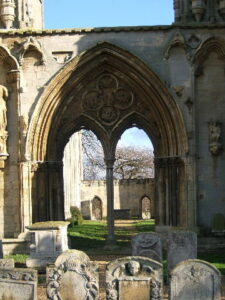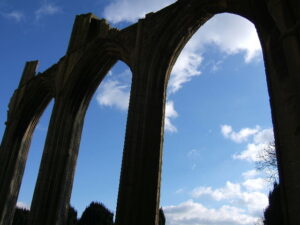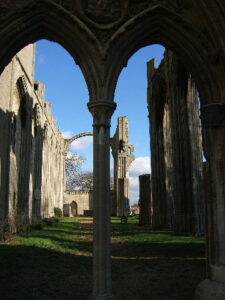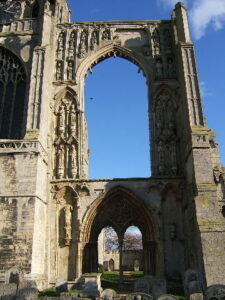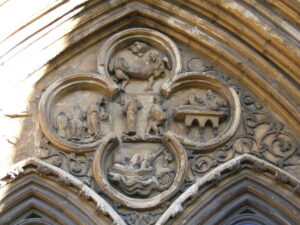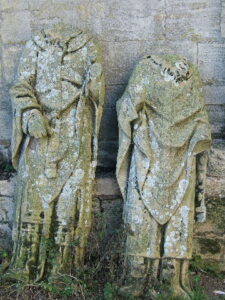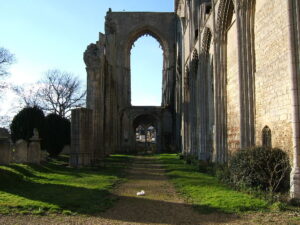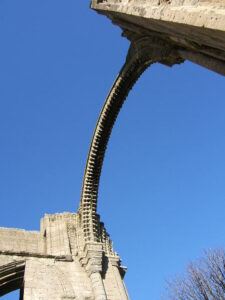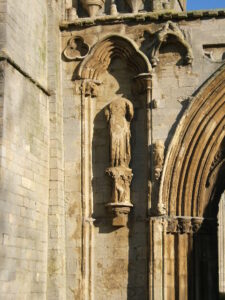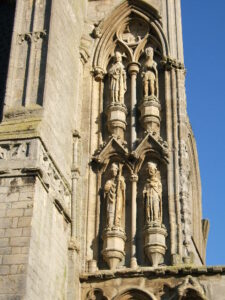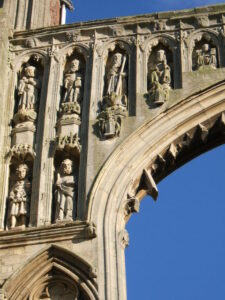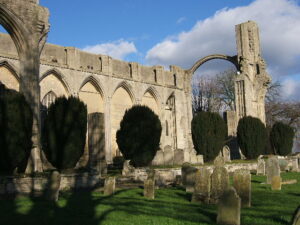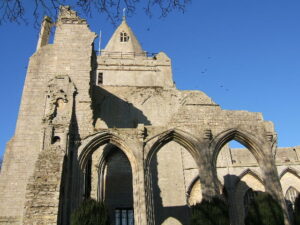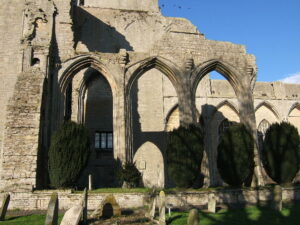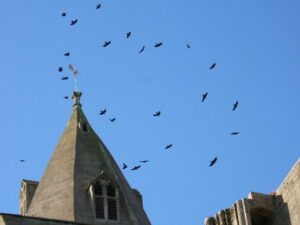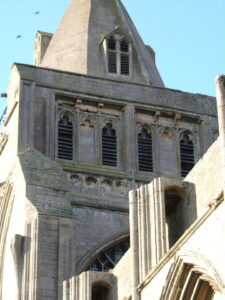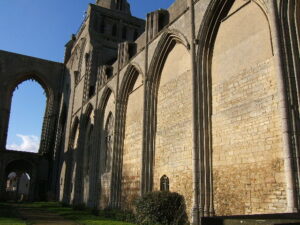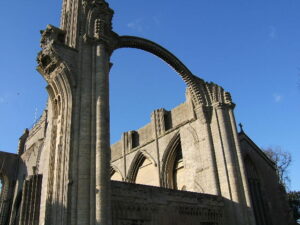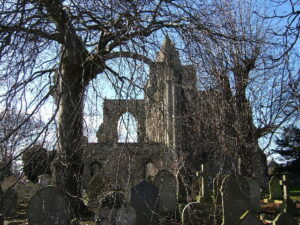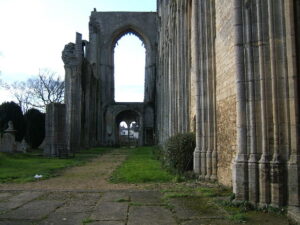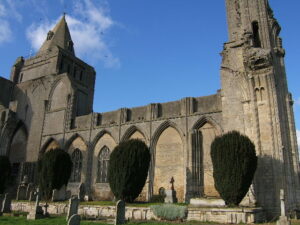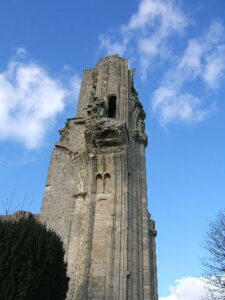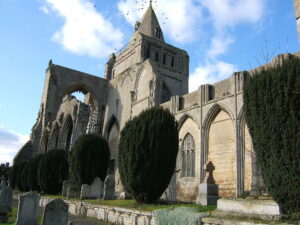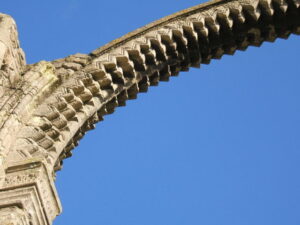Crowland Abbey
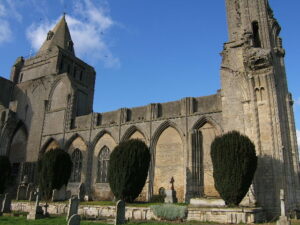 Crowland Abbey (Croyland) story started at the very end of the 7th century. When a young man named Guthlac, who was a soldier and a son of a Mercian nobleman decided to give up the military life to become a monk. After two years at Repton in Derbyshire at the age of 24, he sought greater seclusion and obtained permission to adopt the life of a hermit. With a boatman and a servant Guthlac sought a desolate spot in the Fens and landed on the island of Croyland on St Bartholomew’s day, 699 AD.
Crowland Abbey (Croyland) story started at the very end of the 7th century. When a young man named Guthlac, who was a soldier and a son of a Mercian nobleman decided to give up the military life to become a monk. After two years at Repton in Derbyshire at the age of 24, he sought greater seclusion and obtained permission to adopt the life of a hermit. With a boatman and a servant Guthlac sought a desolate spot in the Fens and landed on the island of Croyland on St Bartholomew’s day, 699 AD.
Guthlac and his companions set up small cells and a simple oratory, here he lived until his death in 714 AD. It was a miserable existence and it is told that Guthlac dressed in skins and the only nourishment he took was a scrap of barley bread and a small cup of muddy water after sunset! He suffered from Ague and marsh fever and the inhabitants of the island were rough and barbarous.
Guthlac gained a reputation for holiness of life, and was visited by many people in search of spiritual counsel. One who came to him was Ethelbald, a pretender to the throne of Mercia, fleeing from his cousin Coelred. Guthlac prophesied that Ethelbald would become King, and Ethelbald vowed that if this should happen he would build an Abbey on that site in honour of Guthlac. He fulfilled his vow by laying the foundation stone on St Bartholomew’s Day, 716 AD.
In the early days of the Abbey, according to the Croyland Chronicles, Ethelbald gave extensive lands to the Monks of Crowland, which he guaranteed in a Charter. The first buildings were probably wood or wattle with thatched roofs, of which nothing remains, apart from some oak piles used for the foundations which have been unearthed.
In 870 AD the Danes over-ran the country, and attacked and destroyed the Abbey. The Danes killed the Abbot Theadore and some of the monks, sacked and burnt down the buildings. Some of the monks managed to escape to Thorney where they barely survived as a community.
The Second Abbey
In 946 AD the three remaining monks were visited in their ruined church by Turketyl, the chancellor of King Edred. He was so impressed by their holiness and hospitality that he became a monk and joined their community. Under the direction of the King he restored the monastery, building it in the Saxon style. The community lived according to the Benedictine rule of St Benedict.
The Great Fire
No part of Turketyl’s Abbey now survives, because of a disastrous fire in 1091. Caused when a plumber had been working in the tower. The whole church, monastic buildings, and library which had held all it’s valuable charters and manuscripts plus a curious and costly sphere designed to illustrate the working of the solar system! were destroyed. Ingulphus who was the Abbot at the time immediately set about the Abbeys reconstruction, but his work was all levelled to the ground at the next rebuilding.
During the Abbacy of Ingulphus we are told there were 62 monks belonging to the Abbey, besides over 100 other monks from other monasteries, each of whom had a stall in the choir, a seat in the refectory, and a bed in the dormatory.
At this time Hereward the Wake was leading a resistance against the Normans, and was finally said to have been buried at Croyland Abbey with his wife Torfrida, and perhaps his mother, Lady Godiva.
The Third Abbey
In 1109, Joffrid of Orleans became the 15th Abbot, and began a most extensive reconstruction of the church and monastery building in the Norman style. In 1113, 28 foundation stones were laid for the new building. A great feast and meal was held for more than 5000 people within the Abbey precincts, whilst the Abbot of Thorney, and of Croyland and 400 monks were fed in the refectory. In 1118 an earthquake destroyed much of the new work at Croyland, which was yet without a roof. Parts of Joffrid’s Abbey can still be seen:
The fine Norman dog-tooth west arch of the central tower
The west front of the south aisle and doorway into the north aisle
The eastern halves of the two most easterly arches of the Nave
The font, built into the south pier of the east arch of the tower
The Chronicle states that, during the abbacy of Joffrid, monks were sent from Croyland to Cambridge. In 1428 Abbot Lytlington, established in Cambridge a Hostel for student-monks of the Benedictine Order, wjhich was later to become Magdalene College. The Heraldic Arms of the Abbey can still be seen in the quadrangle of that College.
In 1143 another fire destroyed a great part of the work begun by Joffrid.
The Fourth Abbey
Successive Abbots undertook further rebuildings and alterations: Henry de Longchamps built the West Front from the spring of the arch to the top, Abbots Overton, Upton and Lytlington built in the Perpendicular style, William of Wermington a master mason, whose monument can be seen in the tower, was responsible for the vaulting in the north aisle. The North-West tower was built in 1427.
(Ref 16)
